WOW. The Chicago Bulls’ official site has reverted to its 90s design, which I remember very clearly. Nostalgia bomb.



This site is made possible by member support. ❤️
Big thanks to Arcustech for hosting the site and offering amazing tech support.
When you buy through links on kottke.org, I may earn an affiliate commission. Thanks for supporting the site!
kottke.org. home of fine hypertext products since 1998.
Entries for February 2015
The Real Don Draper
Vice did a nice little feature on George Lois, the kind of 1960s big-egoed ad man on which Mad Men’s Don Draper was based.
Lois created a number of iconic ad campaigns as well as dozens of fantastic Esquire covers. Or at least he says he did. ;) (via devour)
Update: Here’s the transcript for the episode of This American Life in which Sarah Koenig interviews her father Julian Koenig about George Lois taking credit for some of his best ideas.
In my instance, the greatest predator of my work was my one-time partner George Lois, who is a most heralded and talented art director/designer, and his talent is only exceeded by his omnivorous ego. So where it once would’ve been accepted that the word would be “we” did it, regardless of who originated the work, the word “we” evaporated from George’s vocabulary and it became “my.”
Of course, Koenig also claims to have invented thumb wrestling and to have popularized shrimp in America, so… (via @kevinmeyers)
The world’s worst contract
In 1997, Max-Hervé George’s father bought a unique policy from a French insurance company that functions like Grays Sports Almanac from Back to the Future II, only for financial markets. The policy allows George to invest in investment funds offered by the insurance company at prices up to a week old, essentially traveling back in time with knowledge of which investments will increase in price the most.
For instance, he might have his money in an Aviva fund invested in the French stock market. Lets say the Nikkei 225 rises 5 per cent during the week. He’ll tell Aviva to move his investments into its Japanese fund, at the price before the market moved.
At last report, in 2007, George’s investments were worth €1.4 million and growing at a rate of 68.6% per year. Assuming that rate holds and he continues investing his entire allocation optimally, George will be a billionaire in five years, would be able to buy the insurance company in question by 2025, and be worth a whopping €234 billion by 2030.
See also how you could have turned $1000 into $167 billion by trading the S&P 500 perfectly last year.
Thanks to The Quarter Century Pant for sponsoring the site. Made in America w/ a 25-year guarantee; get yours today:
How BuzzFeed won #TheDress sweepstakes
The internet went crazy yesterday three separate times: when the FCC officially endorsed Net Neutrality, when two llamas escaped, and over the color of this dress.1 A solid three meme day. That scuffling sound you hear is the media scrambling to deliver all sorts of different takes on What It All Means™. The only one I really read, and the only one I’m going to link to, is Paul Ford on why Buzzfeed got 27 million pageviews for #TheDress2 and some other site didn’t.
What I saw, as I looked through the voluminous BuzzFeed coverage of the dress, is an organization at the peak of a craft they’ve been honing since 2006. They are masters of the form they pioneered. If you think that’s bullshit, that’s fine — I think most things are bullshit too. But they didn’t just serendipitously figure out that blue dress. They created an organization that could identify that blue dress, document it, and capture the traffic. And the way they got that 25 million impressions, as far as I can tell from years of listening to their people, reading them, writing about them, and not working or writing for them, was something like: Build a happy-enough workplace where people could screw around and experiment with what works and doesn’t, and pay everyone some money.
This is not said as an endorsement of BuzzFeed. BuzzFeed is utterly deserving of insanely paranoid criticism just like anyone who makes money from your attention, including me. But it’s worth pointing out that their recipe for traffic seems to be: Hire tons of people; let them experiment, figure out how social media works, and repeat endlessly; with lots of snacks. Robots didn’t make this happen. It was a hint of magic, and some science.
I’m reminded of a story about Picasso, possibly apocryphal:
Legend has it that Pablo Picasso was sketching in the park when a bold woman approached him.
“It’s you — Picasso, the great artist! Oh, you must sketch my portrait! I insist.”
So Picasso agreed to sketch her. After studying her for a moment, he used a single pencil stroke to create her portrait. He handed the women his work of art.
“It’s perfect!” she gushed. “You managed to capture my essence with one stroke, in one moment. Thank you! How much do I owe you?”
“Five thousand dollars,” the artist replied.
“B-b-but, what?” the woman sputtered. “How could you want so much money for this picture? It only took you a second to draw it!”
To which Picasso responded, “Madame, it took me my entire life.”
Similarly, designer Paula Scher took only a few seconds to come up with the new logo for Citibank for which Pentagram likely charged big money for:
How can it be that you talk to someone and it’s done in a second? But it is done in a second. it’s done in a second and in 34 years, and every experience and every movie and every thing of my life that’s in my head.
Ford is exactly right about BuzzFeed; they put in the work for years so that a post that took probably 3 minutes to write captured more traffic in one day than some media outlets get in an entire month. (thx, @DigDoug & @jayfallon)
Update: A post from BuzzFeed’s publisher, Dao Nguyen, explains how the company’s tech team reacted to the unexpected traffic.
We have a bunch of things going for us at this point. We have heavily invested in infrastructure provisioning and scaling. We know exactly how to scale fast from running drills.
Weirdly, I saw the dress as gold and a light blue. What a fucking cliche I am, needing to see even this dress as a different set of colors than anyone else.↩
I don’t think I’m betraying any confidences here in saying that BuzzFeed had to spin up a few extra servers to handle the intense burst of traffic from that post…everyone does it. That’s right, dedicated #TheDress servers. Move over, Bieber.↩
The Origin of Joy Division’s Unknown Pleasures Album Cover Art

For Scientific American, Jen Christiansen tracks down where the iconic image on the cover of Joy Division’s Unknown Pleasures came from. Designer Peter Saville found the image, a stacked graph of successive radio signals from pulsar CP 1919, in a 1977 astronomy encyclopedia but it actually originated in a 1970 Ph.D. thesis.
By now I had also combed through early discovery articles in scientific journals and every book anthology on pulsars I could get my hands on to learn more about early pulsar visualizations. The more I learned, the more this descriptor in the 1971 Ostriker caption began to feel significant; “computer-generated illustration.” The charts from Bell at Mullard were output in real time, using analogue plotting tools. A transition in technology from analogue to digital seemed to have been taking place between the discovery of pulsars in 1967 to the work being conducting at Arecibo in 1968 through the early 1970’s. A cohort of doctoral students from Cornell University seemed to be embracing that shift, working on the cutting edge of digital analysis and pulsar data output. One PhD thesis title from that group in particular caught my attention, “Radio Observations of the Pulse Profiles and Dispersion Measures of Twelve Pulsars,” by Harold D. Craft, Jr. (September 1970).
When a star gets old and fat, it explodes in a supernova, leaving a neutron star in its wake. Neutron stars are heavily magnetized and incredibly dense, approximately two times the mass of the Sun packed into an area the size of the borough of Queens. That’s right around the density of an atomic nucleus, which isn’t surprising given that neutron stars are mostly composed of neutrons. A teaspoon of neutron star would weigh billions of tons.
A pulsar is a neutron star that quickly rotates. As the star spins, electromagnetic beams are shot out of the magnetic poles, which sweep around in space like a lighthouse light. Pulsars can spin anywhere from once every few seconds to 700 times/second, with the surface speed approaching 1/4 of the speed of light. These successive waves of electromagnetic pulses, arriving every 1.34 seconds, are what’s depicted in the stacked graph. Metaphorical meanings of its placement on the cover of a Joy Division record are left as an exercise to the reader.
Arcade Intelligence
Then something happens. By the three hundredth game, the A.I. has stopped missing the ball.
The New Yorker’s Nicola Twilley on the computer program that learned how to play Breakout and other Atari games. All on its own. Artificial Intelligence Goes to the Arcade.
Messi scores 64 goals at once
Here are 64 goals scored by FC Barcelona legend Lionel Messi, presented simultaneously in one frame.
Fusion’s Cara Rose DeFabio has dubbed this type of video The Superfuse.
Karl Ove Knausgaard travels through America
The NY Times Magazine got Karl Ove Knausgaard (author of My Struggle) to “drive across America and write about it without talking to a single American”, like some sort of introverted Tocqueville. He came unprepared:
I dialed the number of the driver’s-license office at the Swedish Transport Agency, keyed in my personal identity number and sat down at the desk, scrolling through some Norwegian newspapers as I waited my turn.
A prerecorded voice came on and informed me about opening hours, then the line went dead.
What the hell?
Had they closed?
But it couldn’t be later than 1 p.m. in Sweden.
I looked at the Transport Agency website. To my dismay, I discovered that it was a holiday in Sweden tomorrow, Trettondagsafton, the Feast of the Epiphany, and a half-day today.
That meant I couldn’t get the driver’s-license confirmation letter until three days from now at the earliest, more likely four.
Oh, no.
I wasn’t even in the U.S. yet, I was just in Canada!
I lay back in bed and stared at the ceiling. I should email The Times and explain the situation. Maybe they had a solution. But I couldn’t. I just couldn’t bring myself to tell them that I’d undertaken this great road-trip assignment across the U.S. without my license. They’d think I was a complete idiot.
In any case, there was nothing I could do today.
And his thoughts on Detroit (emphasis mine):
I’d seen poverty before, of course, even incomprehensible poverty, as in the slums outside Maputo, in Mozambique. But I’d never seen anything like this. If what I had seen tonight - house after house after house abandoned, deserted, decaying as if there had been disaster - if this was poverty, then it must be a new kind poverty, maybe in the same way that the wealth that had amassed here in the 20th century had been a new kind of wealth. I had never really understood how a nation that so celebrated the individual could obliterate all differences the way this country did. In a system of mass production, the individual workers are replaceable and the products are identical. The identical cars are followed by identical gas stations, identical restaurants, identical motels and, as an extension of these, by identical TV screens, which hang everywhere in this country, broadcasting identical entertainment and identical dreams. Not even the Soviet Union at the height of its power had succeeded in creating such a unified, collective identity as the one Americans lived their lives within. When times got rough, a person could abandon one town in favor of another, and that new town would still represent the same thing.
Was that what home was here? Not the place, not the local, but the culture, the general?
Update: The Times has posted the second part of Knausgaard’s My Saga.
If there is something to be gained, if it is gainable, no power on earth can restrain the forces that seek to gain it. To leave a profit or a territory or any kind of resource, even a scientific discovery, unexploited is deeply alien to human nature.
Bingeclock tracks how long you’ll need if you plan on binge-watching various TV shows. Law and Order? 19 days.
Design Ah! introduces kids to design concepts
Ah-Ha to Zig-Zag

I’m a big fan of Maira Kalman but somehow missed a book she illustrated that came out in October, Ah-Ha to Zig-Zag: 31 Objects from Cooper Hewitt, Smithsonian Design Museum.
“A. Ah-ha! There you Are.” begins Maira Kalman’s joyfully illustrated romp through the treasures of Cooper Hewitt’s design collection. With her signature wit and warm humor, Kalman’s ABC book introduces children and adults to the myriad ways design touches our lives. Posing the question “If you were starting a museum, what would you put in your collection?”, Kalman encourages the reader to put pen to paper and send in personal letters — an intimate, interactive gesture to top off her unique tour of the world of design. Objects ranging from a thirteenth-century silk thinking cap to 1889 tin slippers with bows, all the way to Gerrit Rietveld’s Zig-Zag chair are brought to colorful life. Kalman’s hand-lettered text is whimsical and universal in turns, drawing lessons as easily from a worn old boot as a masterpiece of midcentury modernism. Irresistibly, we are led to agree, “Everything is design.”
(via tinybop)
Your father is a convicted serial killer. How do you forgive something like that?
A Few Silent Men
Someone edited the courtroom scene from A Few Good Men and took out all the dialogue, leaving just the reaction shots. It’s surprisingly coherent and dramatic.
See also Dr. Phil without dialogue and musicless music videos. (via @pieratt)
Errol Morris’ short films for ESPN
Director Errol Morris has directed six short films for ESPN collective titled “It’s Not Crazy, It’s Sports.” The films will air on March 1 and then be released online during the following week. The trailer:
The films’ subjects include Mr. Met, streakers, sports memorabilia fanatics, an electric football league, and Michael Jordan’s stolen jersey. I’ll post the films here as they’re released online. Morris previously did a film for ESPN about the sports-themed funerals of die-hard fans.
Update: Grantland has posted the first short film in the series about an electric football league that’s been running in a NY basement for over 30 years.
Update: All of the Morris’ shorts have now been posted on Grantland. Go. Watch.
How is Stephen Hawking still alive?
An Oscar presented to the actor who played him was just the latest honor presented to a man who has no shortage of amazing achievements. But Stephen Hawking’s most amazing — and mysterious — achievement could be the fact that he’s alive. From WaPo: How Stephen Hawking, diagnosed with ALS decades ago, is still alive.
Eating peanuts prevents peanut allergies
The results of a major new trial, published in the New England Journal of Medicine, indicate that for children who are at risk of developing a peanut allergy, eating peanuts greatly reduces the chance of an allergy. This is pretty huge news.
All the babies were between 4 and 11 months old when they were enrolled, and all had either an egg allergy, severe eczema, or both-putting them at high risk of a peanut allergy down the road. Indeed, 98 of them were already heading in that direction: They tested positive for mild peanut sensitivity in a skin-prick test. This meant that these babies were already churning out antibodies to the peanut protein. Eating peanuts in the future could set off an allergic reaction.
The team divided the babies into two groups. Half were to avoid eating peanut products until they were 5 years old. The other half received at least 6 grams of peanut protein a week, spread across at least three meals, until they were 5 years old. Bamba was the preferred offering, though picky eaters who rejected it got smooth peanut butter.
Around the 5th birthdays of the trial subjects came the big test. The children consumed a larger peanut portion than they were used to in one sitting, and the results were clear-cut. Among 530 children who had had a negative skin-prick test when they were babies, 14% who avoided peanuts were allergic to them, compared with 2% of those who’d been eating them. In the even higher risk group, the children who were sensitized, 35% of the peanut-avoiders were allergic versus just over 10% of the peanut eaters.
Even if further studies confirm these results, will American parents start feeding their infants peanuts? I don’t know…there are lots of similarities to vaccines in play here.
Update: Somewhat related: children in developed countries might be growing up too clean, making them more likely to develop allergies.
The findings are the latest to support the “hygiene hypothesis,” a still-evolving proposition that’s been gaining momentum in recent years. The hypothesis basically suggests that people in developed countries are growing up way too clean because of a variety of trends, including the use of hand sanitizers and detergents, and spending too little time around animals.
As a result, children don’t tend to be exposed to as many bacteria and other microorganisms, and maybe that deprives their immune system of the chance to be trained to recognize microbial friend from foe.
That may make the immune system more likely to misfire and overreact in a way that leads to allergies, eczema and asthma, Hesselmar says.
(thx,paul)
Finding Love After a Heart Transplant
Kellan Roberts died suddenly at 22. He had decided to be an organ donor and his heart went to a high school student from Minnesota, Connor Rabinowitz. After receiving the heart, Connor visited Kellan’s family in Seattle and met Kellan’s sister Erin. After a few years, Erin and Connor, well, just watch…this is a wonderful story well told.
The science of anti-vaccination
Host Hank Green of the SciShow looks at the anti-vaccination movement from a scientific perspective: why are US parents growing less likely to vaccinate their children?
In psychology, the search for these explanations is called “Explanatory Attribution” and different people have different “explanatory styles”. Some people are more prone to blame themselves, while others search for an external event to blame. But one thing is clear: we are very bad at not blaming anything. It’s not surprising that parents of children with autism, especially parents who notice a sudden loss of previous development, will search for a possible cause. And when the most significant recent event in the health of the child was a vaccination, as can be said for many moments in the life of a young American, we might identify that as a potential cause and deem that link worthy of further examination.
Now this, is completely logical. The problem is that over a dozen peer-reviewed papers have found no correlation between autism and the MMR vaccine, or any other vaccine for that matter. And yet, when you Google vaccines and autism, a fair number of the results claim that there is a link between the two, and that that link is being covered up either by the government or by big corporations. A parent, already experiencing frustration with the medical community’s inability to tell them why this thing has happened to their child, will, on the internet, find a vibrant community of similarly frustrated people who share their values and experiences. These communities are full of anecdotes that draw connections between vaccines and autism. And so, unsurprisingly, some people become convinced that they have found the reason for their child’s disability.
Once their mind has been made up, confirmation bias sets in. Confirmation bias is simply our tendency to more readily, and with less scrutiny, accept information, anecdotes, and world views that confirm our existing beliefs. And, again, it is a completely normal thing that every person does. Indeed, trying to convince someone that a previously held belief is incorrect has been proven to actually increase their affinity for that idea. And so a community is born, and the safety of vaccines is called into question. And once the procedure for getting a vaccine goes from the doctor telling you that it is now time for a vaccine — and 99% of parents agreeing because that person went through medical school — to it being a question to ponder, vaccination rates will go down.
Hunter S. Thompson calls customer service
This is allegedly a recording of a voicemail that Hunter S. Thompson left for the AV company that wrongly installed his home theater system.
If your setup is still here tomorrow night, I’m gonna destroy it and write about it. Yeah, I write a column, several, I write about a lot of things, you might of heard of the rest of my name somewhere, I write books, I write things that get out and people read! I’ll ruin your fucking name! You goddamn idiots, you fuck up my system!!
We’ve all been there, haven’t we? Perhaps with fewer illicit substances in our systems, but still. (via @davidgrann)
Update: Here’s an interview with someone who worked at the AV company at the time of the call.
The Design Audio/Video team got back to Thompson and fixed the problem which, it turned out, they hadn’t actually caused. The items had actually been sold to the author by another local dealer, which McCorkle knows but would not name.
“It turns out, we didn’t sell him the stuff, but we ended up fixing it for him,” McCorkle said. “In true Hunter style, he never apologized for it, but he was grateful.”
(via @StephenSilver)
Ten years ago yesterday, I started working on as my full-time job. Thanks for reading. -@jkottke
Philip Glass’ soundtrack for Errol Morris’ A Brief History of Time

Philip Glass did the soundtrack for A Brief History of Time, Errol Morris’ documentary on Stephen Hawking, but it was never released as an album. Until earlier this month. Huzzah! Appears to only be available on iTunes — couldn’t find it on Amazon, Rdio, or Spotify — and I wish they’d done more with that cover. Bleh.
The art of staying aloft
Photographer Gloria Wilson takes photos of birds in flight. A few favorites:



Wilson sells prints of this series in her Etsy shop. (thx, meg)
Space Probes

The Spaceprob.es site tracks the active probes in operation in and around our solar system, from Voyager I (19.56 billion km from Earth) to the Artemis probes (358,000 km away). (via @BadAstronomer)
Update: Spaceprob.es now has a shop with posters, pillows, t-shirts, and stickers.
Thanks to Sophia, The Smart Jump Rope, for sponsoring the site. It’s a fitness tracker w/ companion smartphone app
This new book looks interesting… Sapiens: A Brief History of Humankind
The Hungarian Euro
For her master’s project, Barbara Bernát designed a set of fictional banknotes: the Hungarian Euro.

I am a total sucker for banknote mockups and aside from the simplicity, what caught my eye about Bernát’s project is the one security feature: if you look at the notes under a UV light, you see the skeletons of the animals depicted on the notes:

(via @shaylamaddox)
Visualization of the diversity among winners at the Oscars. Unnecessary spoiler: there’s not much.
The Infinite Hotel Paradox
In a lecture given in 1924, German mathematician David Hilbert introduced the idea of the paradox of the Grand Hotel, which might help you wrap your head around the concept of infinity. (Spoiler alert: it probably won’t help…that’s the paradox.) In his book One Two Three… Infinity, George Gamow describes Hilbert’s paradox:
Let us imagine a hotel with a finite number of rooms, and assume that all the rooms are occupied. A new guest arrives and asks for a room. “Sorry,” says the proprietor, “but all the rooms are occupied.” Now let us imagine a hotel with an infinite number of rooms, and all the rooms are occupied. To this hotel, too, comes a new guest and asks for a room.
“But of course!” exclaims the proprietor, and he moves the person previously occupying room N1 into room N2, the person from room N2 into room N3, the person from room N3 into room N4, and so on…. And the new customer receives room N1, which became free as the result of these transpositions.
Let us imagine now a hotel with an infinite number of rooms, all taken up, and an infinite number of new guests who come in and ask for rooms.
“Certainly, gentlemen,” says the proprietor, “just wait a minute.”
He moves the occupant of N1 into N2, the occupant of N2 into N4, and occupant of N3 into N6, and so on, and so on…
Now all odd-numbered rooms became free and the infinite of new guests can easily be accommodated in them.
This TED video created by Jeff Dekofsky explains that there are similar strategies for finding space in such a hotel for infinite numbers of infinite groups of people and even infinite amounts of infinite numbers of infinite groups of people (and so on, and so on…) and is very much worth watching:
(via brain pickings)
Alto’s Adventure

Alto’s Adventure just came out this morning and is definitely my go-to iOS game for the foreseeable future. The game is a cross between something like Monument Valley (the audio and visuals are beautiful) and Ski Safari, which is still one of my all-time favorites.
Norm Macdonald on SNL 40
In a long series of tweets last night, Norm MacDonald posted a recap of the Saturday Night Live 40th anniversary special from his perspective, from how the writing process started, to running into Paul McCartney in the studio, to trying to get Eddie Murphy into a sketch. Gothamist transcribed the whole thing…you should read it, it’s great.
And then comes Eddie. I’m standing with my son, Lori Jo, and Chris Rock. We see Eddie from 100 yards away. Rock says, “There he is. Like Ali in Zaire.” Eddie, Bomaye. It’s my job to talk him in to doing Jeopardy. We talk in his dressing room a good hour. When it’s over, I’m convinced he’ll do it. He doesn’t. He knew the laughs would bring the house down. Eddie Murphy knows what will work on SNL better than any one. Eddie decides the laughs are not worth it. He will not kick a man when he is down. Eddie Murphy, I realize, is not like the rest of us. Eddie does not need the laughs. Eddie Murphy is the coolest, a rockstar even in a room with actual rockstars.
I’ll reiterate: Macdonald obviously did not deserve to be ranked so low on this Rolling Stone list of all the SNL cast members.
Update: Here’s the original SCTV skit (feat. Eugene Levy, John Candy, and Martin Short) that inspired Celebrity Jeopardy.
Stock Oscars
From Dissolve, a video that recreates scenes from some Oscar winning movies using only stock footage.
The recreated movies include Gladiator, The Social Network, Jurassic Park, and 2001. See also their first effort at this sort of thing.
New Dr. Seuss book: What Pet Should I Get?
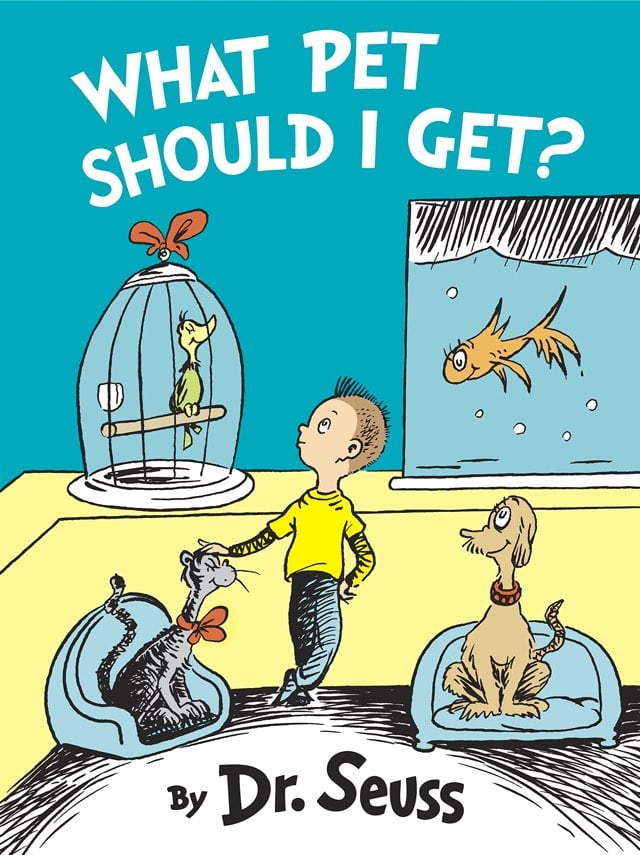
A new Dr. Seuss book will be coming out in July; it’s called What Pet Should I Get?
What happens when a brother and sister visit a pet store to pick a pet? Naturally, they can’t choose just one! The tale captures a classic childhood moment — choosing a pet — and uses it to illuminate a life lesson: that it is hard to make up your mind, but sometimes you just have to do it!
The manuscript for the book was recently discovered by his widow and his secretary while cleaning out his office. Two more new books will be published from other materials they found. (via nextdraft)
Update: The book comes out on July 28. Buzzfeed has an early look at some of the artwork and Michiko Kakutani has a Seussian rhyming review of it in the NY Times.
A new book by the doctor is about to come out.
“What Pet Should I Get?” is its name.
It’s short and it’s Seuss-ish, not “One Fish Two Fish,”
But it does play a similar game.Filled with creatures both real and zany,
It shows off his gift for creating a zoo.
Two-legged, four-legged, winged and finned,
Beasties familiar and entirely new!
An Amazonian tribe sent a 10-yo boy to the US so he could return as an adult to save their village. Did it work?
Neon Chinatown



A project called Chinatown takes familiar logos like Pepsi, Starbucks, UPS, and Lego and translates them, imprecisely, into their Chinese equivalents.
It uses basic words for translation, such as “Caramel Macchiato” for “Starbucks” in order to maintain the visual continuity. By arranging the words this way, ‘Chinatown’ pushes viewers to ask themselves what it means to see, hear, and become fully aware. ‘Chinatown’ also demonstrates our strangeness to 1.35 billion people in the world, when you can’t read Chinese.
(via @pieratt)
The sea of NYC

Jeffrey Linn makes maps that show how extreme sea level increase will impact major cities around the globe. Recently he made a map of NYC showing what it would look like if sea levels rose by 100 feet, which is what would happen if a third of the world’s ice sheets melted. So long, most of Manhattan and Brooklyn; hello Coral Gardens, Prospect Beach, and Sunset Island. Prints are available.
See also Linn’s maps of a drowned London, the bay of LA, and islands of Seattle.
The sounds of Tarantino
A montage of hundreds of sounds from Quentin Tarantino’s movies, from Zed drumming his fingers on top of the gimp’s head in Pulp Fiction to the schiiiiing of The Bride’s Hattori Hanzo sword in Kill Bill.
What are the Coen brothers trying to say?
From Steven Benedict, a short video essay featuring the characters from different Coen brothers’ films talking to each other. According to Benedict, the dialogue reveals three main themes of their movies.
While other essays have assembled several recurring visual tropes: elevators, dogs, dream sequences, bathrooms etc., this essay has the characters talk to one another across the films so we can more clearly hear the Coens’ dominant concerns: identity, miscommunication and morality. Taken as a trinity, these elements indicate that the Coens’ true subject is the search for value in a random and amoral universe.
(via @khoi)
“Did I marry a pathological liar?”
In his new book, Love and Lies: An Essay on Truthfulness, Deceit, and the Growth and Care of Erotic Love, Clancy Martin argues that loving someone requires lying to them. His third wife, Amie Barrodale, recently interviewed Martin about his assertions.
Amie: What if this woman who cheated finds herself fantasizing about it a lot. She’s never contacted the guy, and she never will, but she thinks about him every time she sleeps with her husband.
Clancy: Wow, good one. For the record, you’re my wife, and if this happens, please lie to me about it.
Amie: Wait, that’s a good answer. Why?
Clancy: Because I don’t think I could handle the truth, but I want us to stay married. So I’m asking you to be the strong one, since it’s your deal, your mental affair. If you feel like it’s starting to threaten the relationship — if the only way for us to continue to be happily married is for you to get the truth out — well, then I’d ask you to find a gentle, caring way to do it. Don’t just say: “I can’t stop thinking about this guy I slept with, he was fantastic and had a huge —”
Amie: How come you didn’t go into detail about our marriage, or your previous two marriages, in the book?
Clancy: Two reasons: respect for you and my two previous wives, and respect for my daughters. And also, I guess, fear that you guys would all love me less if I were too bluntly honest. But truthfully there are some things I would love to say, but can’t, because I know they would really hurt people I love.
(via the morning news)
Living the dream
After seeing the Homer Simpson coma theory the other day, a reader sent me this story from an anonymous poster on Reddit who lived 10 years of “a different life” entirely in his head while he was briefly unconscious after being hit by a car.
I met a wonderful young lady, she made my heart skip and my face red, I pursued her for months and dispatched a few jerk boyfriends before I finally won her over, after two years we got married and almost immediately she bore me a daughter.
I had a great job and my wife didn’t have to work outside of the house, when my daughter was two she [my wife] bore me a son. My son was the joy of my life, I would walk into his room every morning before I left for work and doted on him and my daughter.
One day while sitting on the couch I noticed that the perspective of the lamp was odd, like inverted. It was still in 3D but… just.. wrong. (It was a square lamp base, red with gold trim on 4 legs and a white square shade). I was transfixed, I couldn’t look away from it. I stayed up all night staring at it, the next morning I didn’t go to work, something was just not right about that lamp.
No idea if this is actually true, but if so, that’s one of the most terrifying things I’ve ever heard. I had a similar but far less scary experience. A few years ago, I fainted. I was told I was out for about 8-10 seconds, but within that time, I had a dream that lasted for ~30 minutes. The details have faded but at the time, the dream felt very real and super vivid and I was pretty freaked out by it. I can’t imagine what feeling like you’ve lived 10 years in an instant would feel like. (via @monsur)
The Katering Show
About a minute into The Katering Show, I already knew it was going to be my favorite cooking show of all time. In this episode, the toothsome twosome with the Beatlesesque names of McCartney and McLennan make risotto hot wet rice using a Thermomix.
So “what is a Thermomix?” I hear anyone under the age of 33 ask. It’s a blender, a microwave, an ice bucket, and a set of kitchen scales. It’s a gangbang of kitchen appliances that’s created a futuristic robot saucepan. It’s the kind of appliance that your rich mother-in-law gives you as a wedding gift because she doesn’t think you can cook. Or something that you buy yourself because you’ve always wanted to join a cult, but you don’t have the energy for the group sex.
(via digg)
Happy Presidents’ Day
On the intersection of Presidents’ Day and Black History Month, Erica Armstrong Dunbar highlights an uncomfortable truth about George Washington: he was a proud and fervent slave owner.
During the president’s two terms in office, the Washingtons relocated first to New York and then to Philadelphia. Although slavery had steadily declined in the North, the Washingtons decided that they could not live without it. Once settled in Philadelphia, Washington encountered his first roadblock to slave ownership in the region — Pennsylvania’s Gradual Abolition Act of 1780.
The act began dismantling slavery, eventually releasing people from bondage after their 28th birthdays. Under the law, any slave who entered Pennsylvania with an owner and lived in the state for longer than six months would be set free automatically. This presented a problem for the new president.
Washington developed a canny strategy that would protect his property and allow him to avoid public scrutiny. Every six months, the president’s slaves would travel back to Mount Vernon or would journey with Mrs. Washington outside the boundaries of the state. In essence, the Washingtons reset the clock. The president was secretive when writing to his personal secretary Tobias Lear in 1791: “I request that these Sentiments and this advise may be known to none but yourself & Mrs. Washington.”
(via mr)
The cast of SNL, ranked
The SNL 40th Anniversary Special will air this Sunday. From Rolling Stone, a list of all of the regular cast members of SNL, ranked from worst to best. The worst is Robert Downey Jr. (“Making him unfunny stands as SNL’s most towering achievement in terms of sucking”) and the top 10 are:
10. Chevy Chase
9. Gilda Radner
8. Amy Poehler
7. Phil Hartman
6. Bill Murray
5. Dan Aykroyd
4. Mike Myers
3. Tina Fey
2. Eddie Murphy
1. John Belushi
I disagree with Norm MacDonald’s placement near the bottom of the barrel…I always liked his stuff. And Dratch at #16? Was never a fan. Most of the original cast ranks too high…I would have preferred Eddie at #1 over Belushi. My favorites: Dana Carvey and Phil Hartman.
FYI, the guest list for the special is kind of incredible. So far, Bill Murray, Eddie Murphy, Alec Baldwin, Jerry Seinfeld, Jim Carrey, Kristen Wiig, Chevy Chase, Chris Rock, Dan Aykroyd, Will Ferrell, Tina Fey, and about 80 other bold-faced names (Hanks, Taylor Swift, Spielberg, etc.) are all scheduled to appear. (via digg)
When scientists say “the Big Bang,” they mean two possible things. But only one of them is still correct.
Theory: Homer Simpson has been in a coma for 20 years
On Reddit, a fan of The Simpsons recently outlined his theory that Homer Simpson has been in a coma for the past 20 years and everything on the show since mid-1993 has taken place in Homer’s head. Here’s the argument…
In the series’ first clip show, which aired in the fourth season, Bart pranks Homer by shaking up his beer can in a paint shaker. The beer explodes and knocks Homer into a coma. At the end of the episode, Homer is shown waking up from the coma. But maybe he didn’t? As possible evidence, the theorist suggests that’s why the Simpsons never age:
This is why the characters don’t age. Homer remembers Bart, Lisa, and Maggie as 10, 8, and 1 year old, so they will always appear that way in his dreams. He is subconsciously aware of time passing, so his mind will often “update” his memories so that the year they occurred matches up with the age he thinks he is.
And it’s also why the plots on the show became more outlandish after the coma episode:
This is clearly Homer’s imagination running wild. With no real world restrictions, Homer’s mind is able to dream up scenarios of him and his family in fantasies involving him winning a Grammy, his father fighting his boss for buried WW2 treasure, his wife getting breast implants, his infant daughter saving him from drowning, etc.
That’s pretty clever. It immediately reminded me of two things:
1. The entirety of St. Elsewhere took place inside the mind of an autistic kid named Tommy Westphall. And since St. Elsewhere was referenced on other TV shows like Homicide: Life on the Street, that means those shows (and the shows referenced on those shows) also took place in Westphall’s mind.
2. From 1991 to 1994, a show called Herman’s Head aired on Fox. The show took place partially in the main character’s head. Among the cast are two regular Simpsons cast members: Hank Azaria (Moe, Chief Wiggum, Apu, Comic Book Guy, etc.) and Yeardley Smith (Lisa). Super-crazy theory: perhaps Herman’s Head inspired Homer’s coma?
Update: Of course this theory isn’t true. Al Jean, a writer and show runner for The Simpsons during season four, told TMZ that Homer hasn’t been in a coma for the past 20 years. (thx, greg)
The DWR Champagne Chair Contest
The winners have been announced in the 2015 edition of the always-charming DWR Champagne Chair Contest in which contestants compete to build the coolest little chairs using only a single champagne cork. The winner and the runner-up:


I actually like the second place chair more than the winner. You can check out all of the submissions to the contest on the main contest page, including this fantastic swiveling chair:

(via @fromedome)
The coming American megadrought of 2050

A recent paper by three climate scientists concludes there’s a high risk of an unprecedented drought in the Southwest and Midwest United States later this century, even if we manage to get our carbon emissions under control. The scientists say it’ll be drier in the Western US than at any point in the past 1000 years.
In the Southwest and Central Plains of Western North America, climate change is expected to increase drought severity in the coming decades. These regions nevertheless experienced extended Medieval-era droughts that were more persistent than any historical event, providing crucial targets in the paleoclimate record for benchmarking the severity of future drought risks. We use an empirical drought reconstruction and three soil moisture metrics from 17 state-of-the-art general circulation models to show that these models project significantly drier conditions in the later half of the 21st century compared to the 20th century and earlier paleoclimatic intervals. This desiccation is consistent across most of the models and moisture balance variables, indicating a coherent and robust drying response to warming despite the diversity of models and metrics analyzed. Notably, future drought risk will likely exceed even the driest centuries of the Medieval Climate Anomaly (1100-1300 CE) in both moderate (RCP 4.5) and high (RCP 8.5) future emissions scenarios, leading to unprecedented drought conditions during the last millennium.
Eric Holthaus has the layperson’s explanation of the study and its implications.
Smerdon’s study is the first to examine the future risk of “megadrought” in the southwest and central United States in the context of historical episodes of drought in the same regions. Smerdon’s study suggests that the coming years are likely to see droughts worse than the epic dry periods that are thought to have caused profound changes to human settlement in the region over the last millennium.
“They’re ‘mega’ because they are droughts that lasted in these regions for multiple decades,” said Smerdon in an interview with Slate. “We haven’t seen anything like this since at least the 1400s.” In comparison, the current California drought is four years old, though drought has been present in most of the last 15 years somewhere in the West.
Update: This NASA video provides a quick overview of this study and what it means for our climate.
The Michael Jordan of ________
Calling someone “the Michael Jordan of [whatever they’re good at]” is a familiar journalistic trope. A team at the WSJ decided to search through the newspapers of the world for mentions of the Jordans and LeBrons of their professions.
Calling someone “the Michael Jordan of…” or, more recently, “the LeBron James of…” is a trope that acknowledges excellence in a way that everyone can understand. So with the NBA getting set to host its annual All-Star Game, the Wall Street Journal went on a hunt for all of the Michael Jordans and LeBron Jameses in newspapers around the world. We found thousands, including the Michael Jordan of bagpipers and private detectives, and the LeBron James of yodeling and midwives.
Some examples:
Jimmy McIntosh, the Scotsman who started Carnegie Mellon’s bagpipe program, calls Gillies the Michael Jordan of piping.
We are the Michael Jordan of onion growers, Butch Peri said. “We started off as the smallest onion grower in the state of Nevada, and in 1999, we became the largest producer in the world of fresh market onions, the kind you buy in the grocery store.”
If you were to convert him from his importance in science to the sports world, Charles Darwin would be the Wayne Gretzky or the Michael Jordan of biology, says Dr. Greg Bole, a bioscientist from the University of B.C. “He shaped the field.”
With a medical cause ruled out, I was forced to accept reality… my son is just really good at screening things out. No, let me rephrase that. The boy is the LeBron James of selective hearing, the Michael Phelps of tuning me out. He’s a best-in-class parental ignorer, and actually it would be kind of admirable… if it wasn’t so infuriating.
This is surely the Tiger Woods of fun Friday links. (via @lauratitian)
Update: According to Google, describing people as “the Michael Jordan of ________” in books has been on the decline since 1999. (thx, david)
The many causes of America’s decline in crime
There’s been a decline in crime in America. On the surface, it may seem like that drop is due to the fact that we’ve locked up so many people. But a new report suggests otherwise. From The Atlantic: The many causes of America’s decline in crime.
+ FiveThirtyEight: “Pick a stat, any stat. They all tell you the same thing: America is really good at putting people behind bars.” (There are some mind-boggling numbers and charts in this piece.)
+ The Marshall Project: 10 (not entirely crazy) theories explaining the great crime decline.
A regular expression for finding prime numbers
Given that there’s so much mathematicians don’t know about prime numbers, you might be surprised to learn that there’s a very simple regular expression for detecting prime numbers:
/^1?$|^(11+?)\\1+$/
If you’ve got access to Perl on the command line, try it out with some of these (just replace [number] with any integer):
perl -wle 'print "Prime" if (1 x shift) !~ /^1?$|^(11+?)\\1+$/' [number]
An explanation is here which I admit I did not quite follow. A commenter at Hacker News adds a bit more context:
However while cute, it is very slow. It tries every possible factorization as a pattern match. When it succeeds, on a string of length n that means that n times it tries to match a string of length n against a specific pattern. This is O(n^2). Try it on primes like 35509, 195341, 526049 and 1030793 and you can observe the slowdown.
Seagull contrails
Using a tiny bit of post-processing, the flight paths of seagulls become visible in this video:
How Peanuts Got Its First Black Character
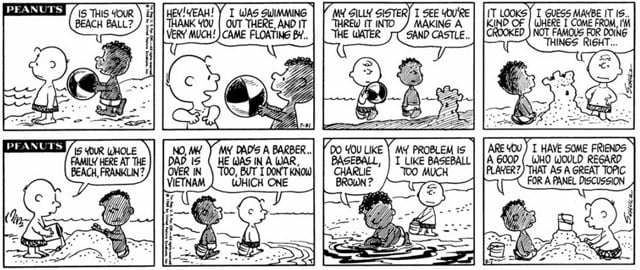
Franklin, the first black member of Charles Schulz’s Peanuts gang, made his debut in July 1968. His presence came about through the efforts of Los Angeles schoolteacher Harriet Glickman, who wrote Schulz several letters in the wake of Martin Luther King Jr’s assassination arguing that the inclusion of black characters in the most popular comic strip in America would be a positive thing. Here is her initial letter to Schulz:
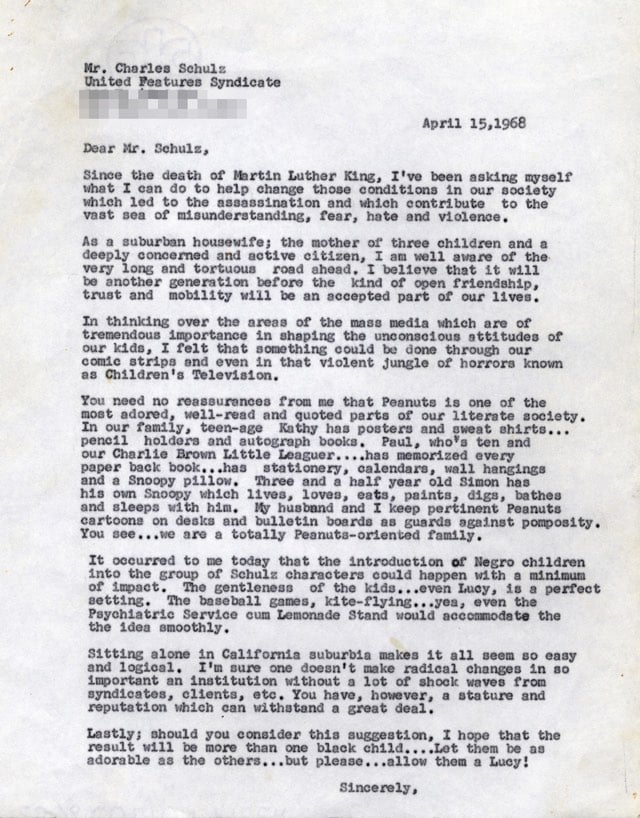
After some back and forth between Schulz and Glickman, Franklin made his first appearance in the strip.
Franklin’s introduction was part of a five-day sequence featuring Sally tossing away Charlie Brown’s beach ball and Franklin rescuing it. In some ways, this seems an aggressive bit of integration — many American public beaches, while no longer legally segregated, were still de facto segregated at the time. In other ways, the strips suggest what might be seen today as an excess of caution; of the twenty panels of the series, Franklin is in ten panels and Sally is in eight, but never is Franklin in the same panel as the white girl. Franklin would not reappear for another two and a half months, when he came for a visit to Charlie Brown’s neighborhood. He was somewhat lighter skinned here, which seems to be less a matter of trying to make him acceptable to the readers and more a matter of cutting back on shading lines which were overpowering his facial features. Franklin’s job in this series was to react to the oddness of the neighborhood kids, and that was a precursor to what would be his primary role in the strip as a whole. Perhaps due to excessive caution, Franklin was never granted any of the sort of usual quirks that define a Peanuts character, the very sort of mistake that Glickman was warning about when she called for one of the black kids to be “a Lucy.”
His inclusion made news nationally and upset many people, particularly in the South. Schulz had a conversation with the president of the comic’s distribution company:
I remember telling Larry at the time about Franklin — he wanted me to change it, and we talked about it for a long while on the phone, and I finally sighed and said, “Well, Larry, let’s put it this way: Either you print it just the way I draw it or I quit. How’s that?”
(via @essl)
Wooper
Wooper is a Robot Chicken parody of Looper, in which cartoon characters like Elmer Fudd are sent back in time to be killed because they can’t show guns in children’s cartoons anymore.
(via @gruber)
Vintage Weekly Bus Passes


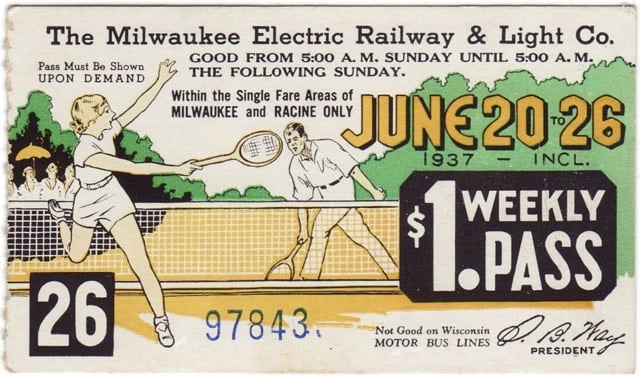
A collection of weekly bus passes from Milwaukee, WI. Years covered are 1930-1979. Was there a new design every single week? (via @slowernet)
Daft Punk soundboard

A keyboard-controlled soundboard for Daft Punk’s Harder, Better, Faster, Stronger. See also the Beyonce Soundboardt. (via waxy)
The problem with action movies today
In this persuasive video, Chris Stuckmann argues that today’s action movies are mostly bad and provides six reasons why.
His fifth point, the camerawork, drives him a little crazy.
Shakycam. Fucking shakycam. At some point, someone somewhere told Hollywood that people like incoherent incompetent camera work, blinding the audience with multiple cuts and assaulting us with nothing but a barrage of sound effects that are supposed to subconsciously tell us that something is happening on screen.
See also how to do action comedy from Every Frame a Painting and Chaos Cinema from Mattias Stork. (via devour)
The Jinx: The Life and Deaths of Robert Durst
From HBO and director Andrew Jarecki (Capturing the Friedmans), comes The Jinx: The Life and Deaths of Robert Durst, a six-part documentary series on reclusive millionaire Robert Durst and the three unsolved murders he is suspected of committing. The first episode aired over the weekend and is now free to watch on YouTube (in the US). A couple of reviews: The Anti-Serial and HBO’s Crime Drama ‘The Jinx’ Succeeds Where Others Fail.
On sitting at the bar
David Chang is exactly right: when dining at a restaurant, often the best option is to sit at the bar.
When everyone’s so close, it changes the dining experience. Out on the floor, you’re a dickhead if you overhear a conversation and chime in. Not at the bar. You connect, trade stories, then trade bites. I’ve never shared as much food with strangers as I have at the bar. You meet great people that way — you’re part of this band of outsiders within the restaurant. And for me, that’s the best possible dining experience of all.
I almost always eat at the bar at my regular place.
The reimprisonment of homosexuals in Germany after WWII
After the end of World War II in Europe, homosexual prisoners of liberated concentration camps were refused reparations and some were even thrown into jail without credit for their time served in the camps. From the United States Holocaust Memorial Museum:
After the war, homosexual concentration camp prisoners were not acknowledged as victims of Nazi persecution, and reparations were refused. Under the Allied Military Government of Germany, some homosexuals were forced to serve out their terms of imprisonment, regardless of the time spent in concentration camps. The 1935 version of Paragraph 175 remained in effect in the Federal Republic (West Germany) until 1969, so that well after liberation, homosexuals continued to fear arrest and incarceration.
After 1945, it was no longer a crime to be Jewish in Germany, but homosexuality was another matter. Paragraph 175 of the German Criminal Code had been on the books since 1871. An English translation of the earliest version read simply:
Unnatural fornication, whether between persons of the male sex or of humans with beasts, is to be punished by imprisonment; a sentence of loss of civil rights may also be passed.
In Germany, homosexuality was considered a crime worthy of up to five years of imprisonment until Paragraph 175 was voided in 1994.
Update: I missed this while writing the post: Paragraph 175 was amended in 1969 to limit enforcement to engaging in homosexual acts with minors (under 21 years). (thx, eric)
LOTR’s One Ring explainer
Here’s a good explanation of what the One Ring from Lord of the Rings actually is and what it can do:
I transcribed a short passage from the video:
First, the ring tempts everyone (well, almost everyone) with promises that yes, this little ring can be a mighty weapon or a tool to reshape the world and gosh don’t you just look like the best guy to use it. Let’s go vanquish the powerful demigod who lives over there to get started, shall we? This is why the hobbits made great ring bearers, because they’re pretty happy with the way things are and don’t aspire to greatness. Of course, there’s Gollum, who started out as a hobbit, but all things considered, he held out pretty well for a couple hundred years. Set the ring on the desk of most men and they wouldn’t be able to finish their coffee before heading to Mordor to rule the world and do it right this time.
What’s interesting about hearing of The Ring in this focused way is how it becomes a part of Tolkien’s criticism of technology. The Ring does what every mighty bit of tech can do to its owner/user: makes them feel powerful and righteous. Look what we can do with this thing! So much! So much good! We are good therefore whatever we do with this will be good!
The contemporary idea of the tech startup is arguably the most seductive and powerful technology of the present moment, the One Ring of our times. It’s not difficult to modify a few words in the passage above to make it more current:
First, the startup tempts everyone (well, almost everyone) with promises that yes, this little company can be a mighty weapon or a tool to reshape the world and gosh don’t you just look like the best guy to use it. Let’s go disrupt the powerful middleman who lives over there to get started, shall we? This is why the nerds made great ring bearers, because they’re pretty happy with the way things are and don’t aspire to greatness. Of course, there’s Sergey and Larry, who started out as nerds, but all things considered, they held out pretty well for a decade. Set the ring on the desk of most men and they wouldn’t be able to finish their mail-order espresso before heading to Silicon Valley to rule the world and do it right this time.
Ok, haha, LOL, and all that, but it’s curious that nerds (and everyone else) shelled out billions of dollars to watch Peter Jackson’s LOTR movies in the early 2000s in the aftermath of the dot com bust. Those were dark times…the power of the startup had just been lost after Kozmo’s CEO Dave Isildur was slain by economists while delivering a single pint of Ben & Jerry’s Chubby Hubby to far reaches of the Outer Sunset and had not yet been rediscovered by Schachter, Butterfield, and Zuckerberg.
And these nerds, whose spines all tingled when Aragorn charged into the hordes of Mordor — for Frodo! — and whose eyes filled with tears when Frodo parted with Sam at the Grey Havens, came away from that movie experience siding with Boromir, Saruman, and Denethor, determined to seize that startup magic for themselves to disrupt all of the things, defeat the evil corporate middlemen, and reshape the world to be a better and more efficient place. And gosh don’t you just look like the best guy to use it?
Neil Armstrong’s bag of Moon junk
For whatever reason, when Buzz Aldrin and Neil Armstrong left the surface of the Moon after their historic space walk, they collected “a bunch of trash that we want to take back” in a small white bag. Upon their return to Earth, Armstrong put the bag in a closet and there it sat for more than 40 years, until Armstrong’s widow discovered it shortly after his death. Among other items, the bag contained the camera that recorded The Eagle’s landing on the Moon and Armstrong’s first step, which was presumed to have been lost or left on the Moon.

As far as we know, Neil has never discussed the existence of these items and no one else has seen them in the 45 years since he returned from the Moon. (I asked James Hansen, Neil’s authorized biographer if he had mentioned the items, and he had not.) Each and every item has its own story and significance, and they are described with photographs in extraordinary detail in an addendum to the Apollo Lunar Surface Journal. But two of the items are especially timely. Both have been placed on display as part of the recently opened temporary exhibition Outside the Spacecraft: 50 Years of Extra-Vehicular Activity.
The first is the 16mm Data Acquisition Camera that was mounted in the window of the lunar module Eagle to record the historic landing and “one small step” made by Armstrong as humankind first set foot on another world.
How YouTube changed the world
Burning a person alive is not a new act in warfare or intimidation. Far from it. So how did the gruesome burning of a Jordanian pilot become a incident that outraged the world and possibly altered a war? It was on video. Seeing a video changes everything. The existence of video footage can determine what leads the news, what drives public opinion, and what gets lodged in our memories. It can also determine who becomes a celebrity, who gets elected, which products we purchase, and confirm again and again the dominance of the once overlooked house-cat. Whoever controls the video controls the story. And since about 2005, the person who’s controlled the video has been you. You, the cat owner. You, the aspiring singer. You, the citizen journalist. And yes, you the terror group determined to intimidate and remain at the forefront of a global conversation. From The Telegraph: How YouTube Changed the World.
Interactive Matisse cut-outs
If, like me, you couldn’t get it together to make it to the Matisse cut-outs show at MoMA, the NY Times has you covered with an interactive look at the show.
Machine With Concrete
Arthur Ganson is a kinetic sculptor who builds “Rube Goldberg machines with existential themes”. One of his works is called Machine with Concrete, which demonstrates the magic of gear ratios
According to a piece in Make, the input shaft spins at 200 rpm, which is reduced by gearing down to 1 revolution every 2 trillion years by the time you reach the gear on the end…which is so slow that even embedding the final gear in concrete doesn’t make any difference to the machine’s operation. (via interconnected)
Climate change calculator
Brad Plumer of Vox plays around with the climate change Global Calculator and discovers, among other things, eating less beef and slowing the world’s population growth would significantly slow global warming.
The IEA scenario I started with assumed that, by mid-century, the average person will be eating 2,330 calories per day, including 220 calories of meat. It also assumes we’ll be eating more beef — that is, about 25 percent of the world’s meat will come from ruminants like cows, up from 22 percent today. Since cows produce a lot of methane, this is significant.
But what if we tweaked those assumptions? I told the calculator to assume that in 2050, the average person was only consuming 152 calories of meat per day — which is the WHO’s target for a healthy diet. I also assumed that the mix of meat stayed similar to what it was today — marginally less beef, more chicken and pork.
The result? Global greenhouse-gas emissions dropped significantly. We’re now on pace for around 2.5°C of global warming, give or take.
The 75 best-edited movies of all time
From the Motion Picture Editors Guild, a list of the 75 best-edited movies of all time.
As for directors, Alfred Hitchcock is the most often cited, making the list 5 times (although not placing in the top 10), and spanning 3 decades. Right behind him are Steven Spielberg and Francis Ford Coppola, both of whom made the list 4 times. Like Hitchcock, Spielberg’s pictures were released over 3 decades. Coppola’s pictures, however, were all released in the 1970s - with 2 in 1974 (the only director with 2 films in a single year). All of his pictures placed in the top 22 films, with 3 of them in the top 11. At the other end of the continuum, there were 33 years between Terrence Malick’s 2 films on the list.
Directors Stanley Kubrick and Martin Scorsese follow, with 3 films each making the cut. Tied with Malick for 2 pictures are Bob Fosse, William Friedkin, Akira Kurosawa, Christopher Nolan, Ridley Scott, Steven Soderbergh, Orson Welles and Bob Wise; all others received 1 mention.
The top ten:
1. “Raging Bull” (Thelma Schoonmaker, 1980)
2. “Citizen Kane” (Robert Wise, 1941)
3. “Apocalypse Now” (Lisa Fruchtman, Gerald B. Greenberg, Walter Murch, 1979)
4. “All That Jazz” (Alan Heim, 1979)
5. “Bonnie And Clyde” (Dede Allen, 1967)
6. “The Godfather” (William H. Reynolds, Peter Zinner, 1972)
7. “Lawrence of Arabia” (Anne V. Coates, 1962)
8. “Jaws” (Verna Fields, 1975)
9. “JFK” (Pietro Scalia, Joe Hutshing, 1991)
10. “The French Connection” (Gerald B. Greenberg, 1971)
You think of filmmaking as male dominated, but one thing I noticed about that top 10 right away: five women in the list, including three in the top five. (via hitfix)
Update: Women have been well-represented in film editing in part because the job began as menial labor.
For much of Hollywood history, there were virtually no filmmaking opportunities available to women other than screenwriting and acting — with one major exception. Women have always been welcomed — and in many quarters preferred by male directors — as film editors, or “cutters,” as they were originally known. In the early days, the job was regarded as menial labor, and it largely was. Cutters worked by hand, running film on reels with hand cranks and manually cutting and gluing together strips of it. (Moreover, they almost never received screen credit.) After the advent of the Moviola editing machine in 1924, the process became faster and easier, but was still tedious and low paying, which is why most cutters remained young, working-class women.
It was around this time that the job of cutting films became less about just maintaining proper continuity and more about being creative. The Russian films of Sergei Eisenstein introduced the concept of montage — how “colliding” separate pieces of film together could advance a storyline and manipulate viewers’ emotions — and this approach became widely discussed and imitated the world over, not least of all by some of the more enterprising female cutters in America, some of whom, like Margaret Booth, began to experiment with leftover footage on the cutting room floor and proved to be quite inventive.
Oklahoma: earthquake country
The number of earthquakes in Oklahoma has increased dramatically over the past years. There are now more measurable quakes in OK than California or Alaska. Why? Fracking.
Oklahoma recorded more than three times as many earthquakes as California in 2014 and remains well ahead in 2015. Data from the U.S. Geological Survey shows that Oklahoma had 562 earthquakes of magnitude 3.0 or greater in 2014; California had 180. As of Jan. 31, Oklahoma recorded 76 earthquakes of that magnitude, compared with California’s 10.
According to the Advanced National Seismic System global catalog, in 2014, Oklahoma even beat Alaska, the nation’s perennial leader in total earthquakes, though many small events in remote areas go unrecorded there.
BuzzFeed’s Ben Smith scores a sit-down interview w/ Obama. The half-life of those LOL listicle jokes grows shorter.
The secret life of machines
From Tim Hunkin, The Secret Life of Machines is a series of drawings illustrating how everyday objects work, from fax machines to refrigerators to quartz watches.
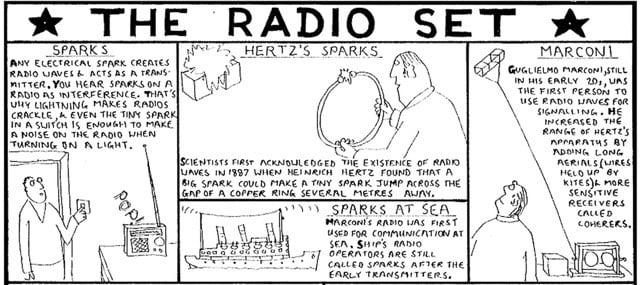
Update: The drawings are nice, but Hunkin’s real The Secret Life of Machines project is this series of videos, uploaded by some kind soul to YouTube:
(via @leftnotracks & john)
How to lose weight in four easy steps. Step 3 is difficult but really works.
Designer real estate for hermit crabs

Artist Aki Inomata builds fanciful new houses for hermit crabs.
Miniature windmills, churches, and even entire cities jut from the surface of her 3D-printed shells, which are modelled upon CT scans of abandoned crab shells and then recreated in transparent resin. Inomata then allows the homeless crabs to inspect the shelters at their leisure — she says “most hermit crabs don’t even glance at” them, but occasionally one of the creatures finds its dream real estate and settles in.
From Dave Wiskus, a brief history of computer user interfaces. Engelbart, Xerox, and Jobs, oh my!
Beautiful hand painted ski trail maps
If you’ve ever noticed most ski trail maps look kinda the same, the reason is many of them have been painted by a single individual: James Niehues.
Each view is hand painted by brush and airbrush using opaque watercolor to capture the detail and variations of nature’s beauty. In many instances, distortions are necessary to bring everything into a single view. The trick is to do this without the viewer realizing that anything has been altered from the actual perspective.
Here’s a selection of his work:



Posthumous hackathon
Jessamyn West writes about the nuts and bolts of dealing with the death of her techie dad, including wresting control from the hidden computer controlling his house and digitally impersonating him to use his apps and cancel cable.
My dad’s retirement home was not quite so high tech but it was designed to provide a certain level of creature comforts with minimal inputs from him. Set it and forget it. An X-10 system turned most of the lights on and off on a schedule. Some of this was pretty straightforward “Turn on the porch lights after dark.” and some was a bit more esoteric “Turn off the office lights at 10 pm so that I’ll know it’s time for bed.” He knew the ruleset. I did not. I’d be working on an article or reading a book and suddenly be plunged into total darkness. I’d poke at some wall switches that would sometimes turn the lights back on.
The system was controlled by a laptop. The laptop died. I removed the hard drive to get at the config files. This project went on a lengthy To Do list and never rose to the top. The lights kept turning on and off. Over time their schedules got out of sync. The driveway lights would stay on for days. The porch lights would never come on, or turn on at 6:15 pm and then off at 6:27. Sometimes they’d just blink on and off and we’d be all “Did you see that?” My sister and I kept lists, tried to discern patterns. I pulled the switches off the walls, only to find that they were just stuck on with tape, with no actual wires underneath. Somewhere in some wall there was a transmitter sending out signals that only the lights could hear.
It’s oddly comforting that even in the digital age, our loved ones can still haunt us from their graves.
Taylor Swift’s Nine Inch Nails
If you take the vocals from The Perfect Drug by Nine Inch Nails and match them to the beats from Taylor Swift’s Shake It Off, you get this little bit of magic:
Update: I totally forgot I’d previously featured this awesomeness: NIN’s Head Like a Hole vs. Carly Rae Jepsen’s Call Me Maybe. Also of note: Mark Romanek directed the videos for Shake It Off and The Perfect Drug. (via ★interesting, @sarahmakespics, and mark)
A Farewell to the Model T
Writing for the New Yorker in 1936, E.B. White pens a farewell to the Model T, a gadget that defined the first quarter of the 20th century.
During my association with Model T’s, self-starters were not a prevalent accessory. They were expensive and under suspicion. Your car came equipped with a serviceable crank, and the first thing you learned was how to Get Results. It was a special trick, and until you learned it (usually from another Ford owner, but sometimes by a period of appalling experimentation) you might as well have been winding up an awning. The trick was to leave the ignition switch off, proceed to the animal’s head, pull the choke (which was a little wire protruding through the radiator), and give the crank two or three nonchalant upward lifts. Then, whistling as though thinking about something else, you would saunter back to the driver’s cabin, turn the ignition on, return to the crank, and this time, catching it on the down stroke, give it a quick spin with plenty of That. If this procedure was followed, the engine almost always responded — first with a few scattered explosions, then with a tumultuous gunfire, which you checked by racing around to the driver’s seat and retarding the throttle. Often, if the emergency brake hadn’t been pulled all the way back, the car advanced on you the instant the first explosion occurred and you would hold it back by leaning your weight against it. I can still feel my old Ford nuzzling me at the curb, as though looking for an apple in my pocket.
Aside from the obvious advantage of price, White details three compelling factors of the Model T, all of which still move car owners to purchase today: quickness, height, and customizability. The Model T was gloriously quick off the line, reaching its top speed of 45 mph, according to White, more quickly than other cars of the age. The driver sat high up in the car, on top of the gas tank, which must have given you the same mighty feeling as driving a huge-ass SUV or pickup truck. And as delivered, the Model T was just functional, leaving ample opportunity for people to add their own touches. For instance, the car didn’t come with a gas pedal (the throttle was hand-operated), speedometer, rear view mirror, or windshield wipers. (via @ftrain, who notes what a great tech blogger White was)
Ocean Gravity
Free diver Guillaume Néry looks like an astronaut floating around in space in this underwater video.
See also this surrealist free diving video and Néry’s underwater base jump. (via ★interesting)
Audio landscapes

Drag and drop an MP3 onto this page and soon you’re flying over a 3D-rendered landscape made with Javascript that pulses in time to the music. (via prosthetic knowledge)
Climate change, vaccines, evolution. Why do so many reasonable people doubt science?
Current paradoxes in cosmology
From the Physics arXiv Blog, a list of paradoxes in modern cosmological physics, i.e. areas where theory and observation disagree, sometimes by a whopping 120 orders of magnitude.
Perhaps the most dramatic, and potentially most important, of these paradoxes comes from the idea that the universe is expanding, one of the great successes of modern cosmology. It is based on a number of different observations.
The first is that other galaxies are all moving away from us. The evidence for this is that light from these galaxies is red-shifted. And the greater the distance, the bigger this red-shift.
Astrophysicists interpret this as evidence that more distant galaxies are travelling away from us more quickly. Indeed, the most recent evidence is that the expansion is accelerating.
What’s curious about this expansion is that space, and the vacuum associated with it, must somehow be created in this process. And yet how this can occur is not at all clear. “The creation of space is a new cosmological phenomenon, which has not been tested yet in physical laboratory,” says Baryshev.
What’s more, there is an energy associated with any given volume of the universe. If that volume increases, the inescapable conclusion is that this energy must increase as well. And yet physicists generally think that energy creation is forbidden.
Baryshev quotes the British cosmologist, Ted Harrison, on this topic: “The conclusion, whether we like it or not, is obvious: energy in the universe is not conserved,” says Harrison.
This is a problem that cosmologists are well aware of. And yet ask them about it and they shuffle their feet and stare at the ground. Clearly, any theorist who can solve this paradox will have a bright future in cosmology.
Luckily, these paradoxes are an opportunity to do some great science.
Superintelligent AI, humanity’s final invention
When Tim Urban recently began researching artificial intelligence, what he discovered affected him so much that he wrote a deep two-part dive on The AI Revolution: The Road to Superintelligence and Our Immortality or Extinction.
An AI system at a certain level — let’s say human village idiot — is programmed with the goal of improving its own intelligence. Once it does, it’s smarter — maybe at this point it’s at Einstein’s level — so now when it works to improve its intelligence, with an Einstein-level intellect, it has an easier time and it can make bigger leaps. These leaps make it much smarter than any human, allowing it to make even bigger leaps. As the leaps grow larger and happen more rapidly, the AGI soars upwards in intelligence and soon reaches the superintelligent level of an ASI system. This is called an Intelligence Explosion, and it’s the ultimate example of The Law of Accelerating Returns.
There is some debate about how soon AI will reach human-level general intelligence — the median year on a survey of hundreds of scientists about when they believed we’d be more likely than not to have reached AGI was 2040 — that’s only 25 years from now, which doesn’t sound that huge until you consider that many of the thinkers in this field think it’s likely that the progression from AGI to ASI happens very quickly. Like — this could happen:
It takes decades for the first AI system to reach low-level general intelligence, but it finally happens. A computer is able understand the world around it as well as a human four-year-old. Suddenly, within an hour of hitting that milestone, the system pumps out the grand theory of physics that unifies general relativity and quantum mechanics, something no human has been able to definitively do. 90 minutes after that, the AI has become an ASI, 170,000 times more intelligent than a human.
Superintelligence of that magnitude is not something we can remotely grasp, any more than a bumblebee can wrap its head around Keynesian Economics. In our world, smart means a 130 IQ and stupid means an 85 IQ — we don’t have a word for an IQ of 12,952.
While I was reading this, I kept thinking about two other posts Urban wrote: The Fermi Paradox (in that human-built AI could be humanity’s own Great Filter) and From 1,000,000 to Graham’s Number (how the process of the speed and intelligence of computers could fold in on itself to get unimaginably fast and powerful).
Magic Mike XXL trailer
I liked Magic Mike and I hope this one is going to be as good, although no McConaughey hey hey girl, so I dunno.
And also, Soderbergh is not returning as director, although he is responsible for the movie’s cinematography, editing, and even some camera operating.
National Geographic’s maps are 100 years old
National Geographic’s cartographic department celebrates its 100th birthday today. Here’s a look back at their work and some of NG’s most memorable maps.


Our family subscribed to National Geographic for awhile when I was a kid. The maps and photos contained within brought this country bumpkin in closer contact with the world at large than even the TV news (which was admittedly all of 13-inches and in B&W to boot).
The kingdom of Westeros in Minecraft
In the time it’s taken George RR Martin to complete zero books in the A Song of Ice and Fire series, a group of dedicated fans has created much of the kingdom of Westeros in Minecraft. Here’s a quick video tour:
The Wall is the most visually impressive element:

According to the FAQ, the in-game map is currently the size of Los Angeles, about 500 square miles. (via devour)
The Unbearable Slowness of Light
Nothing is faster than the speed of light. But compared to the unimaginable size of the Universe, light is actually extremely slow. This video is 45 minutes long and during that time, a photon emitted from the Sun1 will only travel through a portion of our solar system.
In our terrestrial view of things, the speed of light seems incredibly fast. But as soon as you view it against the vast distances of the universe, it’s unfortunately very slow. This animation illustrates, in realtime, the journey of a photon of light emitted from the sun and traveling across a portion of the solar system.
It takes light more than 43 minutes to travel to Jupiter and even to travel the diameter of the Sun takes 4.6 seconds. (thx, andy)
To even fight its way out of the Sun is an incredible journey for a photon. The Sun is so dense that a photon generated at the core is absorbed and re-emitted trillions of times by hydrogen nuclei on its way out. By some estimates, it may take up to 40,000 years for a photon to escape the Sun’s surface and head on out to the cold reaches of space.↩
Philip Glass, superhero composer
File this under #notfromtheonion: Philip Glass is co-composing the score for the new The Fantastic Four movie.
Ahead of 20th Century Fox’s latest superhero reboot of The Fantastic Four, director Josh Trank has confirmed that composer Philip Glass will be scoring the forthcoming film with Marco Beltrami.
Trank, best known for his 2012 film Chronicle, spoke to Collider about his long time admiration for the composer, and said that he had been working with Glass for around a year on the film after contacting his manager.
Previous films scored by Glass include The Hours, Koyaanisqatsi, A Brief History of Time, and The Fog of War. But this actually isn’t too much of a surprising departure for Glass…he did the scores for both Candyman and Candyman II, horror films based on a short story by Clive Barker.
An extensive oral history of Chipotle. At the start, “the break-even was he had to sell 114 burritos a day”.
The 50 best films of the 2010s (so far)
The Dissolve picks the 50 best films of the current decade. Picks 50-26, and picks 25-1. Boyhood, The Social Network, Under the Skin, and Inside Llewyn Davis all rank high. (via @khoi)
Earth Primer
Earth Primer is an upcoming iOS app that bills itself as “A Science Book for Playful People”. It looks amazing:
Earth Primer is a science book for playful people. Discover how Earth works through play-on your iPad. Join a guided tour of how Earth works, with the forces of nature at your fingertips. Visit volcanoes, glaciers, sand dunes. Play with them, look inside, and see how they work.
Earth Primer defies existing genres, combining aspects of science books, toys, simulations, and games. It is a new kind of interactive experience which joins the guided quality of a book with open ended simulation play.
Here’s a quick preview of the app. Can’t wait to explore this, with and without the kids.
Update: The Earth Primer app is now available on the App Store.
The Allure of the NFL
Back in September at the beginning of the NFL season, I wrote a post called I’m quitting football.
I’ve been a steadfast fan of NFL football for the past 15 years. Most weekends I’d catch at least two or three games on TV. Professional football lays bare all of the human achievement + battle with self + physical intelligence + teamwork stuff I love thinking about in a particularly compelling way. But for a few years now, the cons have been piling up in my conscience: the response to head injuries, the league’s nonprofit status, the homophobia, and turning a blind eye to the reliance on drugs (PEDs and otherwise). And the final straw: the awful terrible inhuman way the league treats violence against women.
It’s overwhelming. Enough is enough. I dropped my cable subscription a few months ago and was considering getting it again to watch the NFL, but I won’t be doing that. Pro football, I love you, but we can’t see each other anymore. And it’s definitely you, not me. Call me when you grow up.
So how did I do? I ended up watching four games this season: a random Sunday night game in week 15 or 16, the Pats/Ravens playoff, the Pats/Colts playoff, and the Super Bowl. I’ve been watching and rooting for the Patriots for the past, what, 14 or 15 years now. And more to the point, I’ve been following the Brady/Belichick storyline for almost that long and once it became clear the Pats had a great shot at winning it all, not watching the final acts was just not going to happen, NFL bullshit or not. It would be like putting down one of the best 1200-page books you’ve ever read with two chapters to go and just saying, yeah, I’m not going to read the end of that. And that game last night…I felt *incredible* when Butler intercepted that pass. Life is full of many greater, more fulfilling, and more genuine moments, but there’s no feeling quite like the one when you realize your team has won, especially when that victory has been snatched, semi-literally, from the jaws of near-certain defeat.
But that’s ultimately weak sauce. I don’t feel justified about watching just because I really enjoyed it. I made a commitment to myself and didn’t honor it. I believe the NFL is still a terrible organization and isn’t worth supporting with my attention. For whatever it’s worth, I’m going back to not watching next year, and I hope I fare better.
Update: Bill Simmons, in an epic recap of the final 12 minutes of the Super Bowl, echoes what I was getting at above.
When you’ve been rooting for the same people for 15 years, at some point the stakes become greater. You want that last exclamation-point title. (Just ask Spurs fans.) You want to feel like you rooted for a dynasty, or something close to it, instead of just “a team that won a couple of times.” You want to say that you rooted for the best coach ever and the best quarterback ever, and you want to be constantly amazed that they showed up to save your sad-sack franchise at the exact same time.
Serenading the cattle
Watch as farmer Derek Klingenberg calls his cattle in by playing Lorde’s Royals on his trombone.
I can’t tell if this is the perfect Monday video or the perfect Friday video. Maybe I’ll post it again on Friday and we’ll compare. (via the esteemed surgeon and writer @atul_gawande)




Stay Connected